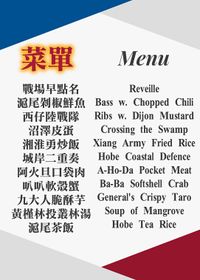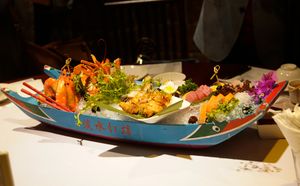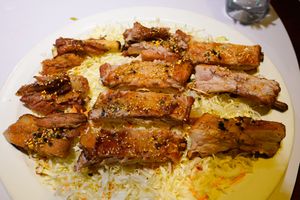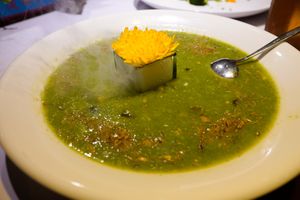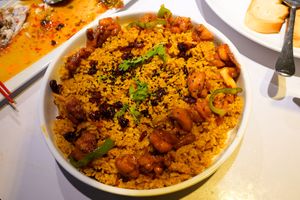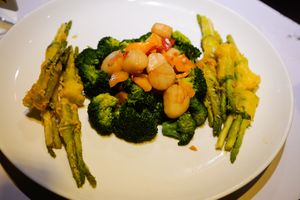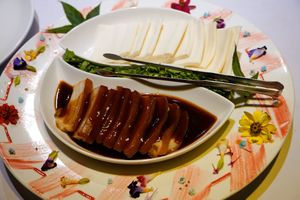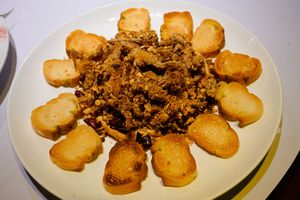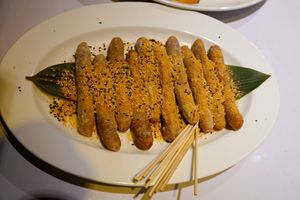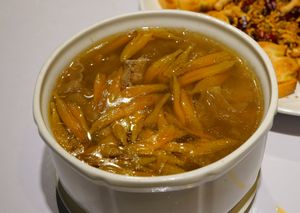"The Hobe Banquet" 修訂間的差異
出自 淡水維基館
小 (Cielo0802 已移動頁面 滬尾宴 至 The Hobe Banquet:改名) |
|||
| 行 1: | 行 1: | ||
| + | ==Menu== | ||
| + | [[檔案:清法戰爭滬尾宴_菜單Menu.jpg|thumb|200px|right|{{檔案:清法戰爭滬尾宴_菜單Menu.jpg}}]] | ||
| + | *[[清法戰爭滬尾宴#戰場早點名|Reveille]] | ||
| + | *[[清法戰爭滬尾宴#滬尾剁椒鮮魚|Dish Name: Bass with Chopped Chili]] | ||
| + | *[[清法戰爭滬尾宴#西仔陸戰隊|Ribs with Dijon Mustard ]] | ||
| + | *[[清法戰爭滬尾宴#沼澤皮蛋|Crossing the Swamp]] | ||
| + | *[[清法戰爭滬尾宴#湘淮勇炒飯|湘淮勇炒飯]] | ||
| + | *[[清法戰爭滬尾宴#城岸二重奏|城岸二重奏]] | ||
| + | *[[清法戰爭滬尾宴#阿火旦口袋肉|阿火旦口袋肉]] | ||
| + | *[[清法戰爭滬尾宴#叭叭軟殼蟹|叭叭軟殼蟹]] | ||
| + | *[[清法戰爭滬尾宴#九大人脆酥芋|General’s Crispy Taro]] | ||
| + | *[[清法戰爭滬尾宴#黃槿林投叢林湯|Soup of Mangrove]] | ||
| + | *[[清法戰爭滬尾宴#滬尾茶飯|滬尾茶飯]] | ||
| + | ===Reveille=== | ||
| + | *Ingredient: Crab, Shrimp, Sashimi, Drunken Chicken, Abalone with Black Soybeans | ||
| + | *Description: Hobe was the most important port in northern Taiwan. Sails were a common sight, and the thriving trade attracted many foreigners. During the Sino Franch-War, the residents of Hobe and the Qing army were busy defending, while, the French army monitored Hobe, ready to action. Foreign merchants packed their belongings, and ready to leave the battlefield. Japaneses individuals, armed with maps and rulers, meticulously observed and measured, while spies busied themselves counting money to profit from the war. | ||
| + | *Design principle: The French army, were fully armed and formidable, resembled heavily armored crabs. The Qing army, numerous but varying in the quality of weapons and personnel, appeared weaker, akin to shrimp. Meanwhile, Japanese observer TōgōHeihachirō enjoyed sashimi aboard the Amagi battle cruiser, watching the battle unfold. | ||
| + | |||
| + | [[檔案:清法戰爭滬尾宴_菜單01.jpg|thumb|300px|center|{{檔案:清法戰爭滬尾宴_菜單01.jpg}}]] | ||
| + | |||
| + | ===Dish Name: Bass with Chopped Chili=== | ||
| + | |||
| + | *Ingredient:Sea Bass with Chili, Scallions, and Garlic | ||
| + | *Description:The French army sees the Qing army like a fresh fish, ready to be enjoyed. However, trying to swallow a well-seasoned fish, especially one with a spicy marinade, can be challenging and might cause discomfort. This was because the morale of the Qing forces, composed of troops from the Xiang, Huai, and local Taiwanese militias, were well-prepared for battle. | ||
| + | *Design principles: Hobe was primarily defended by the Xiang troops, known for their love of spicy food as people from Hunan Province. The Hunanese soldiers were skilled in combat, and a famous dish from Hunan cuisine is fish head with chopped chili. Using two different types of chili peppers, the dish offers rich spiciness and making the taste unique. This design reflects the relations between the Xiang and Huai troops. | ||
| + | |||
| + | [[檔案:清法戰爭滬尾宴_菜單02.jpg|thumb|300px|center|{{檔案:清法戰爭滬尾宴_菜單02.jpg}}]] | ||
| + | |||
| + | ===Ribs with Dijon Mustard === | ||
| + | *Ingredient:Pork Ribs, Bean Sprouts, and Spices | ||
| + | *Description:The French troops at the Battle of Hobe, mainly consisted of French Naval Infantry, known as the Marines. After landing at Shalun, the French troops were divided into five companies, total of 600 men. Each company formed orderly lines on the beach, displaying impressive cohesion and determination. | ||
| + | *Design Principle:The arrangement of the dish reflect the orderly formation of the troops, with pork ribs representing the troops lined up in rows. The plate is covered with white bean sprouts to represent the Shalun beach. The French troops stand on the beach, presenting a magnificent and formidable presence. | ||
| + | |||
| + | [[檔案:清法戰爭滬尾宴_菜單03.jpg|thumb|300px|center|{{檔案:清法戰爭滬尾宴_菜單03.jpg}}]] | ||
| + | |||
| + | ===Crossing the Swamp=== | ||
| + | |||
| + | *Ingredient:Pureed Ceylon Spinach, Preserved Eggs (Iron Eggs), Lean meat, Wolfberry, and Fish | ||
| + | *Description:The fiercest battlefield of the Battle of Hobe was in Wadianbi, just in front of the city's embankment. Here, rice paddies were abundant, and marshes dotted the landscape. The French forces found themselves in a dilemma, unable to advance or retreat effectively. Eventually, they exhausted their ammunition and had no choice but to withdraw. | ||
| + | *Design principle:The design is inspired by the appearance of a marsh, allowing people to experience the conditions of the battlefield. | ||
| + | |||
| + | [[檔案:清法戰爭滬尾宴_菜單04.jpg|thumb|300px|center|{{檔案:清法戰爭滬尾宴_菜單04.jpg}}]] | ||
| + | |||
| + | ===湘淮勇炒飯=== | ||
| + | *菜色:左宗棠雞、蔓越莓等、芝麻、薑黃、米飯 | ||
| + | *意涵:滬尾之役清軍的參戰人員主要是湘軍、淮軍、勇營。大家齊心一致,阻退了法軍的進攻。 | ||
| + | [[檔案:清法戰爭滬尾宴_菜單05.jpg|thumb|300px|center|{{檔案:清法戰爭滬尾宴_菜單05.jpg}}]] | ||
| + | |||
| + | ===城岸二重奏=== | ||
| + | *菜色:蘆筍、花椰菜、黃椒、干貝 | ||
| + | *意涵:滬尾之役期間清軍興築的城岸防禦工事,長達2-3公里,阻擋法軍。外城岸靠近沙崙較為低矮、內城岸則從油車口延伸至滬尾砲台公園一帶。 | ||
| + | [[檔案:清法戰爭滬尾宴_菜單06.jpg|thumb|300px|center|{{檔案:清法戰爭滬尾宴_菜單06.jpg}}]] | ||
| + | |||
| + | ===阿火旦口袋肉=== | ||
| + | *菜色:東坡肉、醃製火龍果、吐司 | ||
| + | *意涵:阿火旦即是張李成,他是臨時招募來的兵勇之一,在近身肉搏戰的時候將法軍包抄,猶如口袋,探囊取物,讓法軍吃盡苦頭。戰後賞賜五品軍功。 | ||
| + | [[檔案:清法戰爭滬尾宴_菜單07.jpg|thumb|300px|center|{{檔案:清法戰爭滬尾宴_菜單07.jpg}}]] | ||
| + | |||
| + | ===叭叭軟殼蟹=== | ||
| + | *菜色:軟殼蟹、蔥、蒜、辣椒 | ||
| + | *意涵:法軍進入沼澤區與城岸之間與清軍的對陣,戰線長達1.5公里,雙方展開齊射。頃刻間,法軍指揮官發現子彈消耗太快,請喇叭手傳令必需節省使用彈藥,無奈喇叭手中彈無法叭叭,最後法軍彈藥用罄兩腿癱軟撤退,因為有人已經用光所有子彈,只能上刺刀。是為叭叭軟殼蟹。 | ||
| + | [[檔案:清法戰爭滬尾宴_菜單08.jpg|thumb|300px|center|{{檔案:清法戰爭滬尾宴_菜單08.jpg}}]] | ||
| + | |||
| + | ===General’s Crispy Taro=== | ||
| + | *Ingredient:Crispy fried taro shaped in long strips | ||
| + | *Description:Taro often regarded as an essential ingredient in Hunan cuisine,ddd also a local specialty of the Tamsui area. Commander Sun KaiHua, commonly known as Sun Jiu or Sir Jiu, had a deep affection for taro based dishes. General Sun played a pivotal role in the Battle of Hobe, hence this dessert was designed to honor his contribution. | ||
| + | *Design principle:As a dessert, it is made of local taro from Tamsui. The taros are mashed into a paste and then deep-fried to perfection. To enhance the flavor, condensed milk is drizzled on top, creating a uniquely delicious treat. | ||
| + | |||
| + | [[檔案:清法戰爭滬尾宴_菜單09.jpg|thumb|300px|center|{{檔案:清法戰爭滬尾宴_菜單09.jpg}}]] | ||
| + | |||
| + | ===Soup of Mangrove=== | ||
| + | *Ingredient:Daylily, Fungus, Mushrooms, Pork Ribs, and Wolfberry. | ||
| + | |||
| + | *Description:After landing at Shalun Beach, the French army encountered dense thickets of yellow hibiscus and mixed forests of camphor trees, hindering their progress. The French army could not move around efficiently in the forest, unable to find the direction, and unable to organize themselves ready to fight. Meanwhile, the Qing army lay in ambush within the forest disguised as spectral figures to intimidate the French troops. They launched surprise attacks from various positions, causing significant difficulties for the French. | ||
| + | |||
| + | *Design principle:This dish is designed to evoke the atmosphere of the jungle. Ingredients such as daylily, fungus, mushrooms, pork ribs and wolfberries are simmered into a clear soup. This allows diner to experience the diversity and complexity of the forest along the Tansui coast, which undoubtedly exceeded the expectations of the French army. | ||
| + | |||
| + | [[檔案:清法戰爭滬尾宴_菜單10.jpg|thumb|300px|center|{{檔案:清法戰爭滬尾宴_菜單10.jpg}}]] | ||
| + | |||
| + | ===滬尾茶飯=== | ||
| + | *菜色:烏龍茶、大米 | ||
| + | *意涵:1884年滬尾居民的主食,用白米或糙米飯或著茶。 | ||
於 2024年6月6日 (四) 21:18 的修訂
目錄
Menu
- Reveille
- Dish Name: Bass with Chopped Chili
- Ribs with Dijon Mustard
- Crossing the Swamp
- 湘淮勇炒飯
- 城岸二重奏
- 阿火旦口袋肉
- 叭叭軟殼蟹
- General’s Crispy Taro
- Soup of Mangrove
- 滬尾茶飯
Reveille
- Ingredient: Crab, Shrimp, Sashimi, Drunken Chicken, Abalone with Black Soybeans
- Description: Hobe was the most important port in northern Taiwan. Sails were a common sight, and the thriving trade attracted many foreigners. During the Sino Franch-War, the residents of Hobe and the Qing army were busy defending, while, the French army monitored Hobe, ready to action. Foreign merchants packed their belongings, and ready to leave the battlefield. Japaneses individuals, armed with maps and rulers, meticulously observed and measured, while spies busied themselves counting money to profit from the war.
- Design principle: The French army, were fully armed and formidable, resembled heavily armored crabs. The Qing army, numerous but varying in the quality of weapons and personnel, appeared weaker, akin to shrimp. Meanwhile, Japanese observer TōgōHeihachirō enjoyed sashimi aboard the Amagi battle cruiser, watching the battle unfold.
Dish Name: Bass with Chopped Chili
- Ingredient:Sea Bass with Chili, Scallions, and Garlic
- Description:The French army sees the Qing army like a fresh fish, ready to be enjoyed. However, trying to swallow a well-seasoned fish, especially one with a spicy marinade, can be challenging and might cause discomfort. This was because the morale of the Qing forces, composed of troops from the Xiang, Huai, and local Taiwanese militias, were well-prepared for battle.
- Design principles: Hobe was primarily defended by the Xiang troops, known for their love of spicy food as people from Hunan Province. The Hunanese soldiers were skilled in combat, and a famous dish from Hunan cuisine is fish head with chopped chili. Using two different types of chili peppers, the dish offers rich spiciness and making the taste unique. This design reflects the relations between the Xiang and Huai troops.
Ribs with Dijon Mustard
- Ingredient:Pork Ribs, Bean Sprouts, and Spices
- Description:The French troops at the Battle of Hobe, mainly consisted of French Naval Infantry, known as the Marines. After landing at Shalun, the French troops were divided into five companies, total of 600 men. Each company formed orderly lines on the beach, displaying impressive cohesion and determination.
- Design Principle:The arrangement of the dish reflect the orderly formation of the troops, with pork ribs representing the troops lined up in rows. The plate is covered with white bean sprouts to represent the Shalun beach. The French troops stand on the beach, presenting a magnificent and formidable presence.
Crossing the Swamp
- Ingredient:Pureed Ceylon Spinach, Preserved Eggs (Iron Eggs), Lean meat, Wolfberry, and Fish
- Description:The fiercest battlefield of the Battle of Hobe was in Wadianbi, just in front of the city's embankment. Here, rice paddies were abundant, and marshes dotted the landscape. The French forces found themselves in a dilemma, unable to advance or retreat effectively. Eventually, they exhausted their ammunition and had no choice but to withdraw.
- Design principle:The design is inspired by the appearance of a marsh, allowing people to experience the conditions of the battlefield.
湘淮勇炒飯
- 菜色:左宗棠雞、蔓越莓等、芝麻、薑黃、米飯
- 意涵:滬尾之役清軍的參戰人員主要是湘軍、淮軍、勇營。大家齊心一致,阻退了法軍的進攻。
城岸二重奏
- 菜色:蘆筍、花椰菜、黃椒、干貝
- 意涵:滬尾之役期間清軍興築的城岸防禦工事,長達2-3公里,阻擋法軍。外城岸靠近沙崙較為低矮、內城岸則從油車口延伸至滬尾砲台公園一帶。
阿火旦口袋肉
- 菜色:東坡肉、醃製火龍果、吐司
- 意涵:阿火旦即是張李成,他是臨時招募來的兵勇之一,在近身肉搏戰的時候將法軍包抄,猶如口袋,探囊取物,讓法軍吃盡苦頭。戰後賞賜五品軍功。
叭叭軟殼蟹
- 菜色:軟殼蟹、蔥、蒜、辣椒
- 意涵:法軍進入沼澤區與城岸之間與清軍的對陣,戰線長達1.5公里,雙方展開齊射。頃刻間,法軍指揮官發現子彈消耗太快,請喇叭手傳令必需節省使用彈藥,無奈喇叭手中彈無法叭叭,最後法軍彈藥用罄兩腿癱軟撤退,因為有人已經用光所有子彈,只能上刺刀。是為叭叭軟殼蟹。
General’s Crispy Taro
- Ingredient:Crispy fried taro shaped in long strips
- Description:Taro often regarded as an essential ingredient in Hunan cuisine,ddd also a local specialty of the Tamsui area. Commander Sun KaiHua, commonly known as Sun Jiu or Sir Jiu, had a deep affection for taro based dishes. General Sun played a pivotal role in the Battle of Hobe, hence this dessert was designed to honor his contribution.
- Design principle:As a dessert, it is made of local taro from Tamsui. The taros are mashed into a paste and then deep-fried to perfection. To enhance the flavor, condensed milk is drizzled on top, creating a uniquely delicious treat.
Soup of Mangrove
- Ingredient:Daylily, Fungus, Mushrooms, Pork Ribs, and Wolfberry.
- Description:After landing at Shalun Beach, the French army encountered dense thickets of yellow hibiscus and mixed forests of camphor trees, hindering their progress. The French army could not move around efficiently in the forest, unable to find the direction, and unable to organize themselves ready to fight. Meanwhile, the Qing army lay in ambush within the forest disguised as spectral figures to intimidate the French troops. They launched surprise attacks from various positions, causing significant difficulties for the French.
- Design principle:This dish is designed to evoke the atmosphere of the jungle. Ingredients such as daylily, fungus, mushrooms, pork ribs and wolfberries are simmered into a clear soup. This allows diner to experience the diversity and complexity of the forest along the Tansui coast, which undoubtedly exceeded the expectations of the French army.
滬尾茶飯
- 菜色:烏龍茶、大米
- 意涵:1884年滬尾居民的主食,用白米或糙米飯或著茶。
